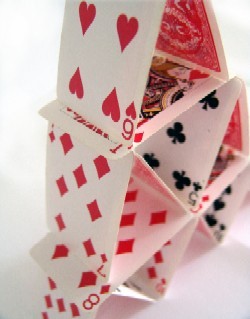St. Ambrose is the patron saint of beekeepers.
Unquote
“I’ve had eighteen straight whiskeys; I think that’s a record.” — Dylan Thomas’ last words
Well Suited
 Bryan Berg builds houses of cards — mansions of cards — and his Cardstacker Gallery has some astounding photos, including a record-breaking 25-foot tower.
Bryan Berg builds houses of cards — mansions of cards — and his Cardstacker Gallery has some astounding photos, including a record-breaking 25-foot tower.
When the Christian Science Monitor asked whether he could build a 100-foot tower, he said, “Sure. But it’s going to take a while.”
“I have to look twice before I move,” he says. “I basically go into slow motion.”
(A 100-foot tower could actually be dangerous. The 25-footer took more than 1,500 decks — about 250 pounds — of cards. “With something that big,” Berg says, “if it fell and you were near it, you’d run the risk of being buried.”)
Berg teaches architecture at Iowa State University, but he says his training didn’t help with the cards. Vice versa, actually: “I would even say that the majority of what I know about the structural behavior of real buildings and building materials came from my experiences building with cards.”
In the Stars
 My horoscope today on astro.com says “this is a good day for a short recreational trip to indulge your desire for beautiful surroundings,” “you should be able to negotiate in business to your advantage,” and “anything that you buy today should prove to be a worthwhile investment.”
My horoscope today on astro.com says “this is a good day for a short recreational trip to indulge your desire for beautiful surroundings,” “you should be able to negotiate in business to your advantage,” and “anything that you buy today should prove to be a worthwhile investment.”
Now, let’s think about that. The current world population is about 6.5 billion, and a twelfth of us are Pisces. Can 540 million people all negotiate favorable business deals on the same day?
Astrologers would say no, those general predictions are worthless, what really counts is a personal reading. Okay, then astrologers should be able to match a person’s birth data with a personalized questionnaire, right? Well, no: A 1994 experiment showed they might as well flip coins.
Even if you accept astrology’s tenets, its reasoning doesn’t make sense. For one thing, the stars are drifting. Due to the precession of Earth’s axis, the stars have moved by 24 degrees during the last 2,000 years. Following the old charts, astrologers are now placing planets in the wrong signs.
For another, that 2,000-year starting point is arbitrary. The heavens change all the time. Four thousand years ago Taurus was the constellation of the vernal equinox. Six thousand years ago it was Gemini.
Anyway, if you’re into this stuff, the rather creepy Horoscopes of Our Time lists precise birth dates and times of various famous people, so you can practice.
Enlightenment
How many Unitarian Universalists does it take to change a light bulb?
“We choose not to make a statement either in favor of or against the need for a light bulb. However, if in your own journey you have found that a light bulb works for you, that is fine. You are invited to write a poem or compose a modern dance about your personal relationship with your light bulb (or light source, or non-dark resource) and present it next month at our annual light bulb Sunday service, in which we will explore a number of light bulb traditions, including incandescent, fluorescent, three-way, long-life, and tinted — all of which are equally valid paths to luminescence.”
“I Still Ate It”
Ye gods. One trip to the Museum of Food Anomalies and you’ll never eat Honey Combs again.
Null and Loyd?
The stupendously brilliant Sam Loyd’s Cyclopedia of 5000 Puzzles, Tricks and Conundrums, with Answers, originally published in 1914, is now available online.
The riddles are pathetic (“What vine does beef grow on? The bo-vine”), but the rest is mostly terrific. One problem: Loyd withheld the solutions to some puzzles, offering a cash prize. He never followed up with the solutions, so they’ve become stumpers. Here’s one, called “The Trader’s Profit”:
A dealer sold a bicycle for $50, and then bought it back for $40, thereby clearly making $10, as he had the same bicycle back and $10 besides. Now having bought it for $40, he resold it for $45, and made $5 more, or $15 in all.
“But,” says a bookkeeper, “the man starts off with a wheel worth $50, and at the end of the second sale has just $55! How then could he make more than $5? You see the selling of the wheel at $50 is a mere exchange, which shows neither profit nor loss, but when he buys at $50 and sells at $45, he makes $5, and that is all there is to it.”
“I claim,” says an accountant, “that when he sells at $50 and buys back at $40, he has clearly and positively made $10, because he has the same wheel and $10, but when he now sells at $45 he makes that mere exchange referred to, which shows neither profit nor loss, and does not affect his first profit, and has made exactly $10.”
“It is a simple transaction, which any scholar in the primary class should be able to figure out mentally, and yet we are confronted by three different answers,” Loyd says. “The first shows a profit of $15, such as any bicycle dealer would; while the bookkeeper is clearly able to demonstrate that more than $5 could not be made, and yet the President of the New York Stock Exchange was bold enough to maintain over his own signature that the correct profit should be $10.”
I’m thinking the accountant’s right, but then I was a journalism major.
Unquote
“The two most common elements in the universe are hydrogen and stupidity.” — Harlan Ellison
Yeah, Hi
For the itinerant gregarious insomniac, here’s how to say “hello” in more than 800 languages.
Pi A La Mode
Where can you see pi expressed to 1 million decimal places?
http://3.141592653589793238462643383279502884197169399375105820974944592.com.
Some questions are pretty easy.
